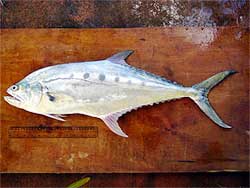Study targets queen of northern seas

The secret life of one of northern Australia’s most popular sportfish, the spectacular queenfish, is being studied by CSIRO scientists for clues to its role and abundance in the marine ecosystem.
The year-long study, co-funded by the National Oceans Office, is collecting more than 30 specimens a month from the Gulf of Carpentaria near Weipa where queenfish are caught by recreational anglers and inshore net fisheries. Results of the study will improve the ability of fisheries managers to sustain queenfish populations into the future.
CSIRO marine biologist Dr Shane Griffiths says queenfish are a major predator of commercially important prawns in the Northern Prawn Fishery, particularly in the Weipa region. Despite their prominence in estuarine and nearshore food webs little is known about the life cycle of queenfish. “By examining the gonads of queenfish specimens we hope to determine when they spawn, their age at sexual maturity, and the number of eggs produced by mature females,” Dr Griffiths says.
“The number of annual growth bands in their otoliths (earbones) will give us clues to their ages and growth rates.” “This information will shed light on how the natural population fluctuates, and how they might respond to certain levels of fishing, either as a target or bycatch species.”
Dave Donald of Dave Donald Sportfishing Charters at Weipa, says queenfish are favoured by anglers for their size, good looks and athleticism. “They grow to more than a metre in length and can weigh up to 16 kilograms,” Mr Donald says. “They are bright silver and are strong fighters on a line, making spectacular jumps when hooked.” “This important research will provide the first account of what make this species tick.”
National Oceans Office planning manager, Rowan Wylie, says information gathered during the project will contribute to the Australian Government’s regional marine plan for northern waters between Torres Strait and the eastern Arafura Sea, including the Gulf of Carpentaria. “Sustainable management of our oceans relies on the best possible information and this project will provide answers on an important species that has received comparatively little scientific attention,” Mr Wylie says.
The queenfish specimens are being collected and sent to the CSIRO Marine Laboratories in Brisbane with the help of Dave Donald Sportfishing Charters, Weipa Sportfishing Club and local commercial fishers.
This study is part of ongoing research in support of the Northern Prawn Fishery and its ecosystem, which has been the focus of CSIRO investigations in the region for more than 40 years.
Contact:
Dr Shane Griffiths, CSIRO Marine Research on 07 3826 7364 or shane.griffiths@csiro.au
Photos of queenfish are available from:
Bryony Bennett, CSIRO Marine Research Communication Group on 03 6232 5261 or bryony.bennett@csiro.au
Media Contact
More Information:
http://www.csiro.auAll latest news from the category: Ecology, The Environment and Conservation
This complex theme deals primarily with interactions between organisms and the environmental factors that impact them, but to a greater extent between individual inanimate environmental factors.
innovations-report offers informative reports and articles on topics such as climate protection, landscape conservation, ecological systems, wildlife and nature parks and ecosystem efficiency and balance.
Newest articles

Properties of new materials for microchips
… can now be measured well. Reseachers of Delft University of Technology demonstrated measuring performance properties of ultrathin silicon membranes. Making ever smaller and more powerful chips requires new ultrathin…

Floating solar’s potential
… to support sustainable development by addressing climate, water, and energy goals holistically. A new study published this week in Nature Energy raises the potential for floating solar photovoltaics (FPV)…

Skyrmions move at record speeds
… a step towards the computing of the future. An international research team led by scientists from the CNRS1 has discovered that the magnetic nanobubbles2 known as skyrmions can be…





















